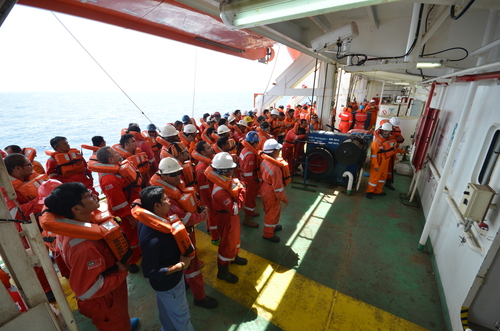One of the worst situations a seafarer can encounter during his/her sea service is the order by the Master to abandon vessel in the face of danger.
If not properly conducted, this operation, instead of saving lives, may lead to unexpected losses. For this not to happen, two main factors come into play:
- Lifesaving Appliances (LSA) readiness, achieved through thorough inspection and maintenance
- Crew familiarization, achieved through training such as abandon ship drills
LSA Readiness
- Equipment availability & condition: LSA onboard should follow the specifications included in SOLAS and LSA code. Special care should be given to the type of ship in order to have additional equipment if required.
- Maintenance: The LSA equipment following SOLAS Maintenance and manufacturers’ maintenance requirements, is to be checked in the specific intervals (generally divided in weekly, monthly, annually and 5yearly intervals). As included in the new amendments of SOLAS (January 2020), authorized and certified personnel, are assigned with the responsibility for inspection & maintenance.
A quick guide as to what should the crew inspect LSA for, as derived by PSC inspection findings for the last 5 years (2016-2020), is the following:
Lifeboats/Rescue boats
- The securing equipment should be in good operable condition
- Launching means should be in good operable condition
- SWL should be included in launching arrangements
- Engine should be able to start successfully
- Battery charger should be connected
- Steering means should operate effectively
- Launching instructions should be present
- Navigational lights should operate effectively
- Proper navigational lights sectors should be present
- Auto stop limit switches should operate effectively
- Windows should not be broken
- Coxswain glass should not be damaged
- Fuel tank should have adequate level of fuel
- Crew seat belts should not be restricted with any means, such as tape
- Painter release device for rescue boat should be flexible and not stacked
Lifejackets/Immersion suits
- The light and whistle should be attached on each lifejacket
- Lifejackets and immersion suits should be available in sizes that fit all and each crew
- Number of lifejackets and immersion suits should be sufficient for the total number of persons onboard
- Lifejackets should not show any sign of compression, loss of resiliency or shrinkage
- Immersion suit zippers should be in working order and the seams intact
Crew Familiarization
To ensure reliable and successful drills, it is imperative that all LSAs are kept in good working order and readily available for immediate use. All components must be easily accessible for inspection and maintenance according to the manufacturers’ recommendations. Crew undertaking drills, inspections, maintenance and the adjustment of LSAs and their associated equipment must be fully trained and familiar with these duties, and preferably certified by the equipment manufacturers.
There are extensive volumes of manuals with operating instructions for each component of combined systems, whereby important information must be extracted and made visible to the operator. Posters or signs shall be provided in way of survival craft and launching controls that clearly illustrate the purpose and the procedures for operating the appliance. The posters and signs should be reviewed to ensure they include and reflect all relevant instructions or warnings.
Fall preventer devices (FPD) are integrated in on-load release mechanisms. As a further simple and effective precautionary measure for inadvertent operation of the on-load release mechanism, additional strops or slings should be considered.































































